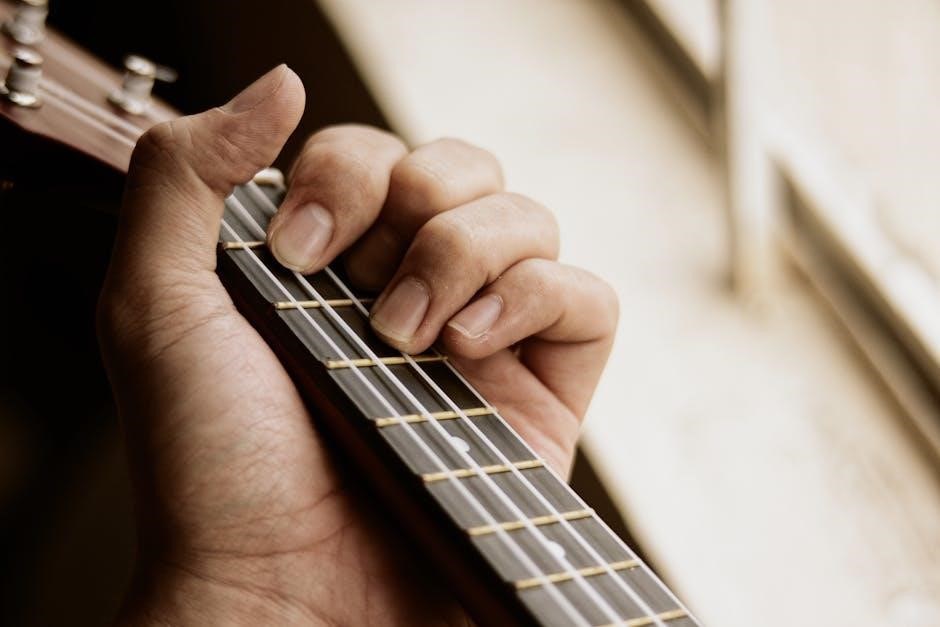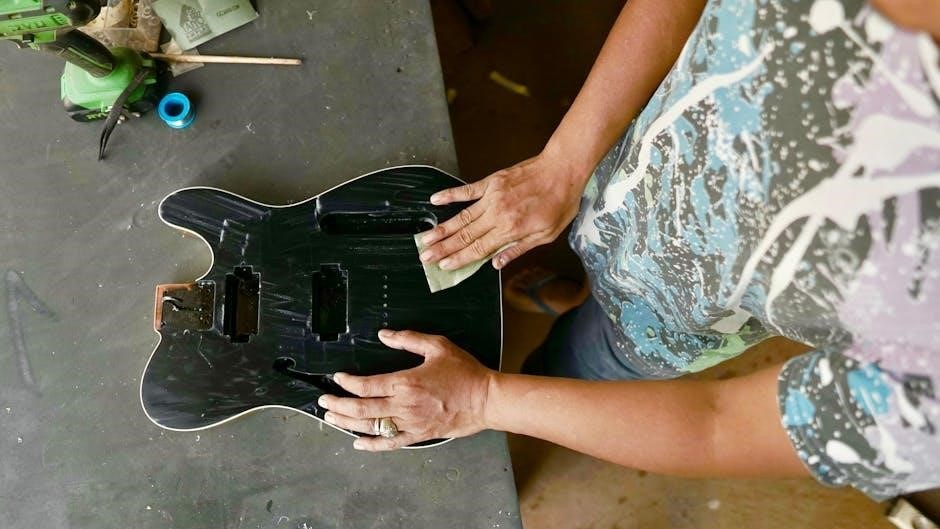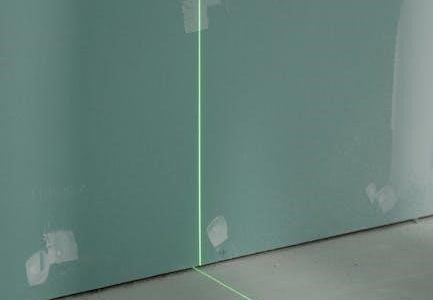Guitar repair is an essential skill for musicians, covering maintenance and fixes. The Guitar Player Repair Guide by Dan Erlewine offers detailed insights, making complex repairs accessible for enthusiasts.
Importance of Guitar Maintenance
Regular guitar maintenance is crucial for preserving its playability and longevity. Proper care prevents issues like fret wear, electronic malfunctions, and damage to the finish. Cleaning, string changes, and adjustments ensure optimal performance. Neglecting maintenance can lead to costly repairs; A well-maintained guitar retains its value and provides consistent tone quality. DIY maintenance empowers players to address minor issues early, avoiding major overhauls. By understanding basic care techniques, guitarists can extend their instrument’s life and keep it sounding its best. Regular maintenance also enhances the overall playing experience, ensuring reliability during performances.
Common Guitar Issues and When to DIY
Guitars often face issues like loose tuning machines, dinged frets, and scratchy electronics. Many of these problems can be resolved with basic DIY techniques. For instance, tightening a loose input jack or cleaning grimy pots is within reach for most players. However, significant repairs, such as refinishing or adjusting the neck, may require professional expertise. Knowing when to tackle a fix yourself or seek help is key. Simple fixes can save time and money, while complex issues demand specialized skills and tools. The Guitar Player Repair Guide offers insights into diagnosing problems and determining the best approach, helping players decide when DIY is appropriate and when professional intervention is necessary.

Essential Tools and Resources
The Guitar Player Repair Guide highlights must-have tools like screwdrivers, wrenches, and fret files. Recommended resources include setup specs for major brands and video tutorials for guidance.
Basic Tools for Guitar Repair
A well-stocked toolkit is crucial for guitar repair; Essential tools include screwdrivers, truss rod wrenches, fret files, and wire cutters. Pliers, tuners, and string winders are also indispensable. These tools help with adjustments, fretwork, and string replacements, ensuring precise and safe repairs. Additionally, an Allen key set and nut slotting files are vital for specific adjustments. The Guitar Player Repair Guide emphasizes having these basics to handle common issues effectively. Proper tools prevent damage and ensure professional-quality results, making them a worthwhile investment for any guitarist or repair enthusiast. They provide the foundation for tackling both minor and more complex repairs confidently and efficiently.
Recommended Resources for Beginners
For those new to guitar repair, several resources stand out as invaluable. Dan Erlewine’s Guitar Player Repair Guide is a comprehensive manual tailored for both beginners and experts. It covers essential tools, step-by-step repairs, and maintenance tips. Additionally, online tutorials and forums offer practical advice and troubleshooting guides. Videos often demonstrate techniques visually, aiding understanding. Books like The Guitar Player Repair Guide provide detailed instructions for common fixes, such as adjusting truss rods or replacing strings. These resources help build confidence and skills, ensuring repairs are done safely and effectively. They are perfect for learning the fundamentals before tackling more complex projects, making them indispensable for any aspiring repair enthusiast.

Cleaning and Preparing the Guitar
Cleaning and preparing your guitar ensures optimal playability and longevity. Start with a thorough clean-up, remove old strings, and eliminate grime. Apply wood polish for protection and re-string with care.
Step 1: The First Clean Up
The initial clean-up is crucial for a successful guitar repair. Begin by inspecting the instrument for dirt, grime, or old wax. Use a soft, dry cloth to wipe down the body, neck, and headstock. Remove any debris from the fretboard and bridge. For tougher spots, dampen the cloth slightly with water, but avoid excessive moisture to prevent damage. This step ensures a clean surface for further repairs and helps identify any hidden issues. Proper cleaning sets the foundation for effective maintenance and restores the guitar’s natural appearance. Regular clean-ups also prevent grime buildup, maintaining the instrument’s playability and longevity.
Step 2: Remove the Strings
Removing the strings is a critical step in guitar repair, allowing access to the fretboard and bridge. Begin by detuning each string slightly to relieve tension. Use a string winder to completely remove them, taking care to avoid snapping. Store the strings safely to reuse or replace later. For old or corroded strings, cut them carefully with wire cutters to prevent damage. This step ensures a safe and efficient repair process, preventing potential harm from loose or breaking strings. Proper removal also avoids interference with further maintenance tasks. Always handle strings with care to maintain the guitar’s integrity and your safety during repairs.

Step 3: Clean Off the Grime
Cleaning off grime is essential for maintaining your guitar’s playability and appearance. Start by wiping down the body with a soft, dry cloth to remove surface dirt. For the neck and fretboard, use a slightly damp cloth, ensuring no moisture seeps between the frets. Avoid harsh chemicals, as they can damage finishes or dry out the wood. For stubborn grime on the fretboard, apply a small amount of fretboard cleaner with a clean cloth, then wipe dry. Use a microfiber cloth to clean hardware like bridges and tuners. Regular cleaning prevents grime buildup, ensuring smooth playability and protecting your instrument from long-term damage.
Step 4: Apply the Wood Polish
Applying wood polish is crucial for maintaining your guitar’s finish and protecting the wood. Use a soft, clean cloth to gently rub the polish onto the body and neck, avoiding electronics. Apply a small amount to the cloth, not directly to the guitar, and work in circular motions. Ensure even coverage but avoid over-saturating the wood. Let the polish sit for a few minutes before buffing with a dry cloth to remove excess and enhance shine. Avoid over-polishing, as it can damage the finish. Test the polish on a small area first to ensure compatibility. Regular polishing maintains the guitar’s appearance and protects it from grime, ensuring long-term preservation and a professional look.
Step 5: Re-Stringing Electric Guitars
Re-stringing your electric guitar is a straightforward process that keeps your instrument sounding its best. Begin by removing the old strings to prevent tangling. Install the new strings one at a time, starting with the low E string, and wind them neatly around the tuning pegs. Leave a small loop at the bridge end for secure fastening. Stretch each string gently to settle it and tune your guitar repeatedly until the strings stabilize. Use a string winder for efficiency and clippers to trim excess string ends. Proper re-stringing ensures optimal playability and tone. Avoid over-tightening, as this can damage the neck or bridge. Regular string changes are essential for maintaining your guitar’s performance and longevity.
Neck and Fretboard Repairs
Neck and fretboard repairs involve adjusting the truss rod for proper alignment and addressing fret issues like wear or buzzing. These fixes are crucial for playability and sound quality.
Adjusting the Truss Rod
Adjusting the truss rod is a critical step in guitar maintenance. It ensures proper neck alignment, preventing warping or buzzing. Using an Allen wrench, tighten or loosen the rod to achieve the desired neck relief. Over-tightening can damage the neck, so small adjustments are recommended. Check the neck relief by pressing the low E string at the first and last frets. A slight gap (0.005-0.015 inches) is ideal. This adjustment improves playability and tone. Resources like Dan Erlewine’s guide provide detailed steps for precise tuning. Regular checks and minor tweaks can prevent major issues, keeping your guitar playing smoothly and sounding its best.
Fixing Fret Issues
Fret issues, such as buzzing or rattling strings, can significantly affect playability. The Guitar Player Repair Guide highlights common fret problems and solutions. Inspect frets for wear or unevenness. For minor issues, leveling and crowning frets can restore smooth playability. Use sandpaper or specialized fret files to flatten uneven frets, then reshape their tops with a crowning tool. Deep grooves or loose frets may require more advanced techniques. Always clean and polish the fretboard after repairs. For severe damage, professional refretting is recommended. Regular maintenance, like checking frets during string changes, can prevent major issues. DIY fixes can save money, but precision is key to avoid further damage. Proper tools and patience ensure a professional-grade result.

Electronics and Hardware
Electronics and hardware are crucial for optimal guitar performance. Common issues include faulty pickups, worn pots, and noisy input jacks. Replacing or upgrading components can enhance tone and reliability.
Diagnosing Electronic Problems
Diagnosing electronic issues in guitars can be challenging but manageable with the right approach. Start by identifying symptoms like crackling sounds, loss of signal, or excessive noise. Next, inspect the wiring and connections for any signs of wear or damage. Check the input jack, volume, and tone pots for proper functionality. Use a multimeter to test for continuity and resistance in circuits. If a component fails these tests, it may need replacement. For pickups, ensure they are securely attached and free from debris. Shielding the guitar’s cavity can also reduce external interference. Always proceed methodically to pinpoint the exact source of the problem before making any repairs.
Replacing Pickups and Pots
Replacing pickups and pots is a common task in guitar repair. Start by disconnecting the old pickups from the wiring harness, ensuring wires are labeled for easy reconnection. Remove the pickup from its mount and install the new one, securing it firmly. For pots, disconnect the wiring and remove the old pot from the control plate. Install the new pot, ensuring proper alignment and secure mounting. Reconnect all wires carefully, following the manufacturer’s wiring diagram. Test the electronics to ensure proper function. Shielding the cavity can reduce noise. This process enhances tone and performance, providing a professional-grade upgrade.
Fixing Input Jacks and Switches
Fixing input jacks and switches is a common DIY guitar repair task. Start by disconnecting the battery or unplugging the guitar for safety. For input jacks, remove the jack plate and unsolder the old jack. Install the new jack, ensuring proper grounding. For switches, take out the old switch and transfer the wires to the new one. Use a soldering iron for secure connections. Clean or replace any corroded parts. Shielding the cavity can reduce noise. Test the guitar to ensure all electronics function properly. These repairs can enhance playability and reliability. Always follow a wiring diagram for accuracy.
Shielding to Reduce Noise
Shielding is a crucial step to minimize hum and noise in guitars. Use conductive materials like copper tape or shielding paint to line the guitar’s electronics cavity. Apply the shielding to the cavity walls and cover any seams or gaps. Solder the tape seams to ensure conductivity. Avoid applying paint directly on electronics. Reassemble the guitar and test for noise reduction. This method effectively blocks electromagnetic interference, enhancing sound quality. Regular maintenance and proper shielding can prevent future issues. Follow a detailed guide for optimal results. Shielding is a simple yet effective way to improve your guitar’s performance and enjoy a cleaner sound.

Body and Finish Repairs
Guitar body and finish repairs address dings, dents, and scratches. Refinishing techniques restore appearance while preserving tone. Professional tools and materials ensure long-lasting results and maintain playability.
Fixing Dings and Dents
Fixing dings and dents on a guitar requires careful assessment to avoid further damage. Small dents can often be addressed with heat application or gentle pressure. For deeper damage, wood filler may be necessary. Once filled, sanding ensures a smooth surface. Afterward, apply a finish touch-up to blend the repair with the surrounding area. Proper techniques are crucial to maintain the guitar’s structural integrity and aesthetic appeal. Always use quality materials and follow step-by-step guides to achieve professional-looking results. This process not only restores appearance but also ensures optimal playability and tone quality, keeping the instrument in prime condition for years to come.
Refinishing Scratches
Refinishing scratches involves restoring the guitar’s surface to its original condition. Start by cleaning the area to remove dirt or grime. Lightly sand the scratch to smooth the edges, feathering it outwards. Apply a matching finish, such as nitrocellulose or polyurethane, using a small brush for precision. Allow the finish to dry completely before buffing to blend seamlessly. For deeper scratches, multiple thin coats may be needed. Proper drying time between coats is essential to avoid peeling or unevenness. This method ensures the guitar’s appearance remains pristine while maintaining its playability and tone. Always use high-quality materials and follow detailed guides to achieve professional results, preserving the instrument’s value and functionality.
Repairing Bridges and Tremolos
Repairing bridges and tremolos is crucial for maintaining tuning stability and playability. For a fixed bridge, ensure the screws are tightened properly and the bridge sits flush on the body. If a tremolo system is loose, check the springs and pivot points, tightening any loose screws. Lubricate the pivot knife edges to ensure smooth operation. For a floating tremolo, adjust the spring tension to balance string pull. If the bridge is warped or bent, professional replacement may be necessary. Always refer to the manufacturer’s specifications for proper setup. Regular maintenance, like cleaning and lubricating, prevents issues and keeps the system functioning smoothly, ensuring optimal performance and tuning stability for the guitar.

Guitar Setup and Adjustments
Guitar setup involves adjusting action, intonation, and string height for optimal playability. Proper truss rod alignment and tuning machine maintenance ensure stability and tone, enhancing overall performance.
Adjusting Action and Intonation
Adjusting the action (string height) and intonation ensures proper playability and tuning accuracy. Start by measuring the string height at the 12th fret using a ruler. For electric guitars, aim for 4/64″ on the low E and 3/64″ on the high E. Acoustic guitars typically require slightly higher action. Use an Allen wrench to adjust the bridge saddles for intonation, ensuring each string plays in tune up the fretboard. Check neck relief by pressing the low E at the first and 17th frets; adjust the truss rod as needed. Precision is key, as small changes significantly impact playability. Always test adjustments by playing chords and melodies across the fretboard to confirm accuracy and comfort.
Setting String Height
Setting string height, or action, is crucial for comfortable playability and minimizing fret buzz. Measure the gap at the 12th fret using a ruler. Electric guitars typically require 4/64″ for the low E and 3/64″ for the high E. Acoustic guitars need slightly higher action, around 5/64″ for the low E and 4/64″ for the high E. Adjust the bridge saddles or bridge height accordingly. For tremolo systems, ensure the springs are balanced. After adjustments, check each string at multiple frets to ensure even playability and proper tuning. If issues persist, consider professional setup. Proper string height balances tone and comfort, making it essential for optimal performance.
Tuning Machine Maintenance
Tuning machine maintenance ensures smooth tuning and prevents mechanical failure. Regularly clean the gears and posts with a soft cloth and mild lubricant. Replace worn or corroded strings to avoid damage. For locking tuners, apply a small amount of graphite or silicone-based lubricant to the screw threads. Check the alignment of the tuning pegs and tighten any loose mounting screws. Lubricate the worm gears if they feel stiff, but avoid over-lubrication, as it can attract dust. For vintage or high-use guitars, consider upgrading to high-ratio tuning machines for better stability. Proper maintenance extends the life of your tuners and keeps your guitar in tune, ensuring optimal performance during practice and performances.
Replacing the Nut
Replacing the nut is a crucial adjustment for achieving proper string action and intonation. The nut is the small, usually plastic or bone piece at the top of the neck that guides the strings. Over time, it can wear down, causing tuning issues and string buzzing. To replace it, measure the string slots with a set of nut slotting files and carefully cut them to the correct depth. Use a ruler to ensure the strings are evenly spaced. Apply a small amount of graphite or silicone-based lubricant to the nut slots to reduce friction. Once installed, tune the guitar and check the action at the first fret. If the strings buzz or rattle, minor adjustments may be needed. Proper installation ensures smooth playability and accurate tuning, making it a worthwhile upgrade for any guitarist. Replacing the nut can significantly improve the overall performance of the instrument.

Advanced Repairs and Considerations
Advanced repairs involve intricate tasks like refinishing, fretboard replacement, or complex electronics work. These require precision tools and expertise, often necessitating professional assistance for optimal results.
When to Seek Professional Help
While many guitar repairs can be tackled with basic tools and knowledge, certain issues require professional expertise. Significant damage, such as cracks in the body or neck, should be handled by experienced technicians to ensure structural integrity. Similarly, complex electronics problems or refinishing tasks may be beyond the scope of DIY efforts. Recognizing your limits is crucial to avoid further damaging your instrument. Consulting a professional guarantees quality results and preserves your guitar’s value and playability. Remember, some repairs are better left to experts to maintain the instrument’s optimal performance and longevity.
Common Mistakes to Avoid
Avoiding common mistakes is crucial for successful guitar repairs. Over-tightening screws or strings can damage hardware or the neck. Using improper tools, like a screwdriver instead of an Allen wrench, can strip screws. Applying too much polish may harm the finish. Neglecting to shield electronics can lead to noise issues. Additionally, rushing through steps or skipping preparation, like cleaning before polishing, can result in subpar outcomes. Following guides carefully and taking time ensures better results. Learning from these pitfalls helps refine your repair skills and protects your instrument from unnecessary harm. Patience and attention to detail are key to achieving professional-quality repairs at home.
Mastering guitar repair boosts confidence and extends your instrument’s life. With patience and practice, you’ll achieve professional results, ensuring your guitar plays and sounds its best.
Final Tips for Successful Repairs
For successful guitar repairs, start with proper preparation and use quality tools. Follow detailed guides like Dan Erlewine’s to avoid common mistakes. Patience is key—take time to ensure each step is done right. Regular maintenance prevents major issues, keeping your guitar in top shape. Don’t hesitate to seek professional help when needed, especially for complex tasks. Keep a well-organized workspace and refer to trusted resources. With practice, you’ll gain confidence and skill, ensuring your guitar plays and sounds its best for years to come. Remember, small fixes now can prevent bigger problems later.



